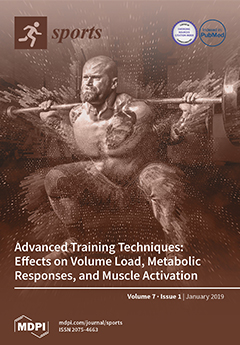This study investigated the effects of advanced training techniques (ATT) on muscular responses and if performing a second training session would negatively affect the training stimulus. Eleven strength-trained males performed a traditional strength training session (TST) and four different ATT: pre-exhaustion A (PE-A), pre-exhaustion B (PE-B), forced repetitions (FR), and super-set (SS). On day 1, SS produced lower volume load than TST, FR, and PE-B (−16.0%,
p ≤ 0.03; −14.9,
p ≤ 0.03 and −18.2%,
p ≤ 0.01, respectively). On day 2, SS produced lower volumes than all the other ATT (−9.73–−18.5%,
p ≤ 0.03). Additionally, subjects demonstrated lower perceived exertion on day 1 compared to day 2 (6.5 ± 0.4 AU vs. 8.7 ± 0.3 AU,
p = 0.0001). For blood lactate concentration [La-] on days 1 and 2, [La-] after the tenth set was the highest compared to all other time points (baseline: 1.7 ± 0.2, fifth-set: 8.7 ± 1.0, tenth-set 9.7 ± 0.9, post-5 min: 8.7 ± 0.7 mmol∙L
−1,
p ≤ 0.0001). Acute muscle swelling was greater immediately and 30-min post compared to baseline (
p ≤ 0.0001). On day 2, electromyography (EMG) amplitude on the clavicular head of the pectoralis major was lower for SS than TST, PE-A, and PE-B (−11.7%,
p ≤ 0.01; −14.4%,
p ≤ 0.009; −20.9%,
p = 0.0003, respectively). Detrimental effects to the training stimulus were not observed when ATT (besides SS) are repeated. Strength trained individuals can sustain performance, compared to TST, when they are using ATT in an acute fashion. Although ATT have traditionally been used as a means to optimize metabolic stress, volume load, and neuromuscular responses, our data did not project differences in these variables compared to TST. However, it is important to note that different ATT might produce slight changes in volume load, muscle excitation, and fluid accumulation in strength-trained individuals from session to session.
Full article






